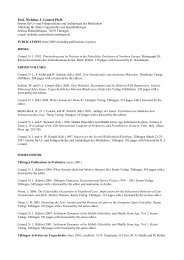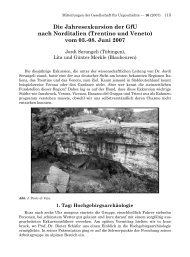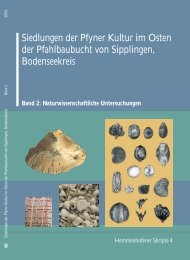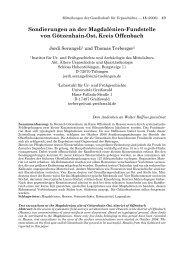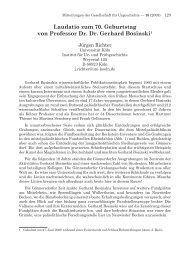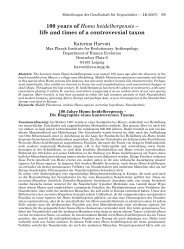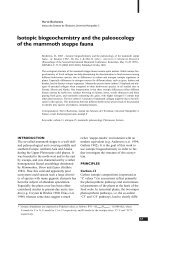bronze age environment and economy in the troad - Universität ...
bronze age environment and economy in the troad - Universität ...
bronze age environment and economy in the troad - Universität ...
Create successful ePaper yourself
Turn your PDF publications into a flip-book with our unique Google optimized e-Paper software.
chapter 1: <strong>environment</strong> <strong>and</strong> archaeology<br />
extend<strong>in</strong>g from <strong>the</strong> Black Sea through <strong>the</strong> Sea of Marmara<br />
towards <strong>the</strong> Aegean. A part of this depression developed as a<br />
fluvial-erosional bas<strong>in</strong> of <strong>the</strong> Palaeo-Karamenderes valley<br />
(Skam<strong>and</strong>er) 50 to 80 km south of Troy. The first <strong>in</strong>vasion of<br />
<strong>the</strong> waters of <strong>the</strong> Mediterranean occurred from c. 70000 BP,<br />
<strong>and</strong> <strong>the</strong> f<strong>in</strong>al capture of <strong>the</strong> Pre-Dardanelles dra<strong>in</strong><strong>age</strong> by rivers,<br />
dur<strong>in</strong>g <strong>the</strong> last Würm glacial regression of <strong>the</strong> sea. The Skam<strong>and</strong>er<br />
developed as a part of <strong>the</strong> nor<strong>the</strong>ast directed, Pre-Dardanelles<br />
dra<strong>in</strong><strong>age</strong> system (Kraft, Kayan <strong>and</strong> Erol 1982). The<br />
Skam<strong>and</strong>er leaves <strong>the</strong> high plateau at P<strong>in</strong>arbaşi, emerges onto<br />
its alluvial pla<strong>in</strong> <strong>and</strong> flows northwards to <strong>the</strong> Dardanelles. The<br />
Simois (Dümrek) river, com<strong>in</strong>g from <strong>the</strong> East, jo<strong>in</strong>s <strong>the</strong><br />
Skam<strong>and</strong>er near its delta.<br />
1.1.2.2 Hydrology <strong>and</strong> hydrography<br />
The Mediterranean river regime differs from o<strong>the</strong>r types of<br />
river regimes <strong>in</strong> its dra<strong>in</strong><strong>age</strong> curve, which extends parallel to<br />
<strong>the</strong> curve of precipitation <strong>in</strong> very short distance. Therefore<br />
heavy precipitation <strong>and</strong> floods <strong>in</strong> w<strong>in</strong>ter <strong>and</strong> spr<strong>in</strong>g, <strong>and</strong> low<br />
waters <strong>in</strong> dry summers are typical (Güldalı 1979). An early,<br />
general <strong>in</strong>vestigation of <strong>the</strong> history of Mediterranean valleys as<br />
witnesses of accumulation <strong>and</strong> deposition was conducted by<br />
Vita-F<strong>in</strong>zi (1969). He recognised two characteristic deposits<br />
with<strong>in</strong> a time span of about 125000 years. The lithologically<br />
diverse <strong>and</strong> badly stratified ‛older fills’, which derive from a<br />
unique depositional phase dat<strong>in</strong>g to <strong>the</strong> last <strong>in</strong>terglacial are<br />
often thought to be of climatic or catastrophic nature. Vita-<br />
F<strong>in</strong>zi (1969) tends towards <strong>the</strong> explanation of chang<strong>in</strong>g surface<br />
vegetation <strong>in</strong>clud<strong>in</strong>g <strong>the</strong> erosion of soils. The well sorted<br />
‛younger fills’ are dated to a much younger period, i.e.<br />
between Roman <strong>and</strong> Middle Ages, with erosion on slopes <strong>and</strong><br />
accumulation <strong>in</strong> <strong>the</strong> valleys. Anthropogenic <strong>in</strong>fluence is<br />
thought to have been considerable. Vita-F<strong>in</strong>zi’s ‛younger fill’<br />
could not be recognised by Kraft, Kayan <strong>and</strong> Erol (1982) <strong>in</strong> <strong>the</strong><br />
Skam<strong>and</strong>er stratigraphy. For this deviation one has to consider<br />
that local factors might have strongly <strong>in</strong>fluenced <strong>the</strong> picture of<br />
<strong>the</strong> Mediterranean valleys. The history of <strong>the</strong> Skam<strong>and</strong>er<br />
valley can be roughly described as follows.<br />
The last lower<strong>in</strong>g of <strong>the</strong> world sea level occurred dur<strong>in</strong>g <strong>the</strong><br />
Würm glaciation (at about 16000 BP) <strong>and</strong> reached a maximum<br />
of about 100 m below present sea level. From that time onward<br />
world sea level rose rapidly (Kraft, Kayan <strong>and</strong> Erol 1982). The<br />
major geomorphic change <strong>in</strong> <strong>the</strong> Skam<strong>and</strong>er pla<strong>in</strong> over <strong>the</strong> past<br />
7000 years was <strong>the</strong> progradation of <strong>the</strong> delta towards <strong>the</strong><br />
Dardanelles. Because of this progradation, <strong>the</strong> coastl<strong>in</strong>e shifted<br />
<strong>in</strong> direction to <strong>the</strong> sea, although <strong>the</strong> sea level rose (Kraft,<br />
Kayan <strong>and</strong> Erol 1982, Kayan 1996). In many Mediterranean<br />
valleys <strong>the</strong> signs of sea-level changes are overlapp<strong>in</strong>g with<br />
alluviation by <strong>the</strong> rivers, which are often assumed to be erosional<br />
processes forced anthropogenically (Vita-F<strong>in</strong>zi 1969). The<br />
accumulation of sediment <strong>in</strong> <strong>the</strong> Skam<strong>and</strong>er delta was caused<br />
by an unknown degree of human activity on <strong>the</strong> low plateau<br />
<strong>and</strong> result<strong>in</strong>g soil erosion (Pustovoytov <strong>in</strong> prep.).<br />
Human <strong>in</strong>fluence on soil erosion is documented s<strong>in</strong>ce antiquity<br />
(e.g. Plato <strong>in</strong> <strong>the</strong> 4th century) <strong>and</strong> is ma<strong>in</strong>ly <strong>in</strong>terpreted as due<br />
to excessive clear<strong>in</strong>g <strong>and</strong> brows<strong>in</strong>g. The rate of delta progression<br />
is often an <strong>in</strong>dicator of <strong>in</strong>l<strong>and</strong> erosion. In <strong>the</strong> case of <strong>the</strong><br />
Skam<strong>and</strong>er delta, erosive processes can be acerta<strong>in</strong>ed s<strong>in</strong>ce <strong>the</strong><br />
Early Bronze Age. The question of anthropogenic <strong>in</strong>fluence is<br />
addressed by Pustovoytov (see 1.1.2.3).<br />
The prehistoric coastl<strong>in</strong>es determ<strong>in</strong>ed by <strong>the</strong> accumulation of<br />
sediment <strong>in</strong> <strong>the</strong> delta of Skam<strong>and</strong>er are well-known from<br />
Kayan’s <strong>in</strong>vestigations (Kraft, Kayan <strong>and</strong> Erol 1982, Kayan<br />
1996). The ru<strong>in</strong> of Troy is six kilometres from <strong>the</strong> delta coast<br />
today, while historical sources from <strong>the</strong> 12th century AD<br />
document <strong>the</strong> coastl<strong>in</strong>e as about two kilometres distance from<br />
<strong>the</strong> “town Truva”. Troy was a coastal settlement at least dur<strong>in</strong>g<br />
<strong>the</strong> Early Bronze Age periods Troy I <strong>and</strong> Troy II, <strong>and</strong> was not<br />
much more than 1 km from <strong>the</strong> sea until Late Roman I. The<br />
same situation is valid for Kumtepe (Map 1).<br />
Today <strong>the</strong> sou<strong>the</strong>astern part of <strong>the</strong> river valley is about 10 m<br />
above sea level. The river regulations <strong>in</strong> <strong>the</strong> 20th century<br />
changed <strong>the</strong> delta region of Skam<strong>and</strong>er from flooded pla<strong>in</strong>s<br />
dur<strong>in</strong>g w<strong>in</strong>ters to a well dra<strong>in</strong>ed river system. S<strong>in</strong>ce this time<br />
<strong>the</strong> accumulation of sediment is negligible.<br />
1.1.2.3 Soils<br />
The reconstruction of <strong>the</strong> prehistoric <strong>environment</strong> is one of <strong>the</strong><br />
central aims with<strong>in</strong> <strong>the</strong> recent archaeological <strong>in</strong>vestigation at<br />
Troy. Soil science is <strong>in</strong>tegrated <strong>in</strong>to Troy project, to <strong>in</strong>vestigate<br />
<strong>the</strong> importance of <strong>the</strong> h<strong>in</strong>terl<strong>and</strong> of Troy, i.e. <strong>the</strong> high <strong>and</strong> particularly<br />
<strong>the</strong> low plateau, on which Troy is situated on <strong>the</strong> most<br />
western edge. Soil represents <strong>the</strong> only autochthonous, palaeogeographic<br />
<strong>in</strong>dicator which can give <strong>in</strong>formation on prehistoric<br />
activity with<strong>in</strong> this locality. Although large regions of <strong>the</strong><br />
Mediterranean l<strong>and</strong>scape are eroded, <strong>the</strong>re are still areas, where<br />
<strong>the</strong> orig<strong>in</strong>al, prehistoric soil is preserved. S<strong>in</strong>ce 1995<br />
Pustovoytov (1995) has <strong>in</strong>vestigated <strong>the</strong> soils <strong>in</strong> <strong>the</strong> vic<strong>in</strong>ity of<br />
Troy.<br />
Pustovoytov (<strong>in</strong> prep.) conducted a prospection of <strong>the</strong> modern<br />
soil-cover <strong>in</strong> <strong>the</strong> h<strong>in</strong>terl<strong>and</strong>, which resulted <strong>in</strong> a soil map of <strong>the</strong><br />
region. Radiocarbon dat<strong>in</strong>g of humus <strong>and</strong> carbonates has given<br />
<strong>in</strong>formation on <strong>the</strong> m<strong>in</strong>imum <strong>age</strong>s of <strong>the</strong> soils. Dat<strong>in</strong>g buried<br />
soils provided <strong>in</strong>formation on <strong>the</strong> beg<strong>in</strong>n<strong>in</strong>g of <strong>the</strong> superposition,<br />
i.e. accumulation of eroded sediment. Palaeobotanical<br />
contents of soil profiles, such as pollen, phytoliths <strong>and</strong> carbonised<br />
macrorema<strong>in</strong>s are still under <strong>in</strong>vestigation, but are<br />
expected to br<strong>in</strong>g <strong>in</strong>formation on <strong>the</strong> former vegetation <strong>in</strong> <strong>the</strong><br />
region.<br />
The follow<strong>in</strong>g summary gives some prelim<strong>in</strong>ary results on <strong>the</strong><br />
development of <strong>the</strong> soil-cover <strong>in</strong> <strong>the</strong> Troad.<br />
The development of <strong>the</strong> soils on <strong>the</strong> high <strong>and</strong> <strong>the</strong> low plateaux<br />
started <strong>in</strong> early Holocene at <strong>the</strong> latest. S<strong>in</strong>ce <strong>the</strong>n, <strong>the</strong> soilcover<br />
on <strong>the</strong> high plateau rema<strong>in</strong>ed almost undisturbed until<br />
now, while <strong>the</strong> low plateau was already partially eroded <strong>in</strong> prehistoric<br />
times. The soil profiles from areas on <strong>the</strong> low plateau<br />
that do not show signs of erosion, reta<strong>in</strong> valuable <strong>in</strong>formation<br />
for <strong>the</strong> reconstruction of <strong>the</strong> l<strong>and</strong>scape. O<strong>the</strong>r objects that<br />
preserve characteristics of <strong>the</strong> ancient l<strong>and</strong>scape are buried<br />
soils, i.e. soils covered with sediment. These overly<strong>in</strong>g sediments<br />
consist of eroded <strong>and</strong> mixed material from old soil horizons.<br />
Buried soils were found <strong>in</strong> rav<strong>in</strong>es on <strong>the</strong> low plateau.<br />
One of those buried soils could be determ<strong>in</strong>ed as a former<br />
plough<strong>in</strong>g horizon, which correlated with arable farm<strong>in</strong>g <strong>in</strong> <strong>the</strong><br />
Byzant<strong>in</strong>e period (around 1100 AD).<br />
Previous research demonstrated <strong>the</strong> coexistence of different<br />
2





